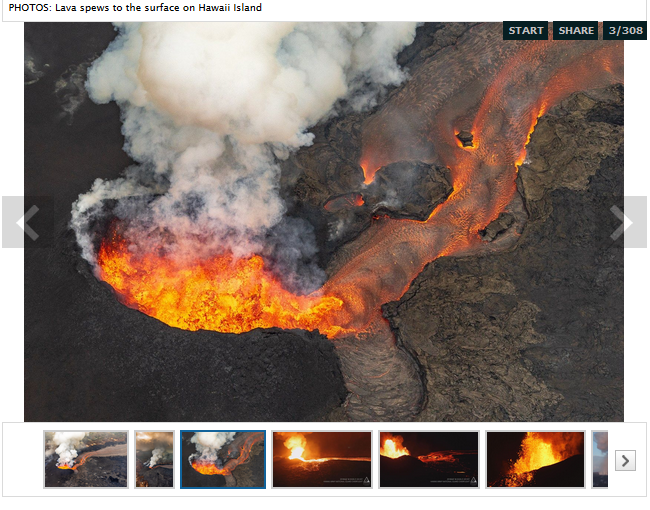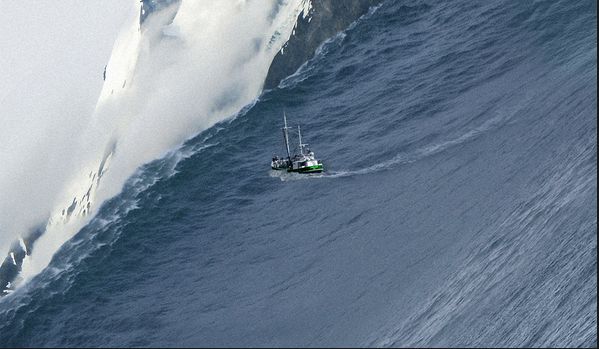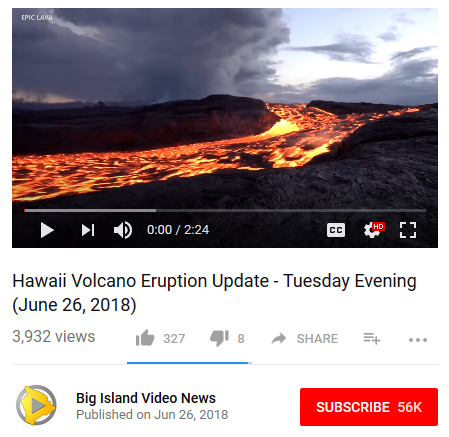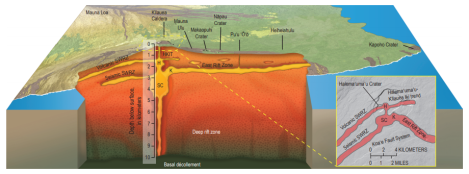Major Jeff Hickman recounts his time on the Big Island as the Hawaii National Guard Public Affairs Officer during the East Rift Zone eruption before returning to Oahu. June21, 2018
USGS Volcano Hazards Program Movie
Video / 1:47 / Page modified: 2018-06-19 19:36:07
In reference of the overlook parking area KilaueaGeology field crews on the ground near the Kīlauea's fissure 8 midday on June 19, 2018 observed a still-vigorous channelized lava flow being fed by lava fountains at the vent. Standing waves are visible within the channel. Cascades/rapids are visible near the base of the cone, which is an estimated 50 m (164 ft) high. The maximum flow velocity in the channel is 7.7 m/s (17 mph). During the morning overflight, several small overflows could be seen along the channel margins. The flow of lava is more rapid in the center of the channel and decreases in speed toward the margins where friction with the channel walls increases. The lava flow forks as it nears the ocean, creating two ocean entry points.
Google kort
https://twitter.com/MilekaLincoln/status/1009238829067202560After 7 weeks, eruptions on Big Island show no signs of stopping
Friday, June 22nd 2018, 9:57 am CEDT
Snip: Video Pics

PAHOA, HAWAII (HawaiiNewsNow) -In lower Puna, seven weeks after eruptions started, a bizarre new normal has set in.
The lava keeps coming, as vigorous as ever. Thousands of evacuees remain in limbo. And the devastation to homes and farms and neighborhoods grows.
On Thursday, fissure no. 8 — by far the most active so far — continued to create tall fountains of lava and was feeding a channelized flow headed toward the sea.
U.S. Geological Survey scientists said the channel was flowing at up to 17 mph in places and creating "rapids" at the base of a lava cone — now 164 feet high — that sits where there used to be homes and roads and yards in Leilani Estates.
Off Kapoho, lava continues to enter the sea, creating new land and plumes of laze — haze and shards of glass.
The delta off Kapoho has grown to a stunning 380 acres since Wednesday, according to officials, while Halemaumau Crater at Kilauea's summit has doubled in size since eruptions began in early May.
And three other fissures were also producing spatter, albeit not quite as profusely.
Another jarring sight: Lava "bergs" as big as vans can be seen in the rivers of lava.
Thomas Mason, who evacuated from his home in Leilani Estates with his wife, said the ongoing eruptions have everyone in "wait and see" mode.
The Masons moved from Maui in November and started building their retirement home on Kupono Street in February. They were just about ready for drywall when the first fissure opened up on Mohala Street on May 3.
Twenty-three additional fissures later, their home is now in an area that's been classified as uninhabitable. Although their house is unfinished, it's still standing. But it's completely inaccessible.
Like so many others, the Masons don't have insurance. And their situation underscores the complexities of a disaster whose end is nowhere in sight.
Since eruptions started May 3, at least 598 homes have been confirmed destroyed. Authorities fear the true figure is upwards of 700.
Lava 'bergs,' rapids and flows part of a bizarre new normal on the Big Island





